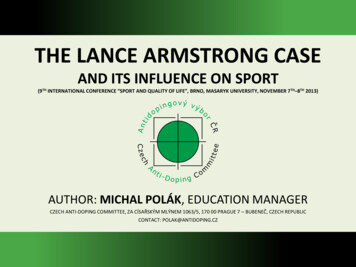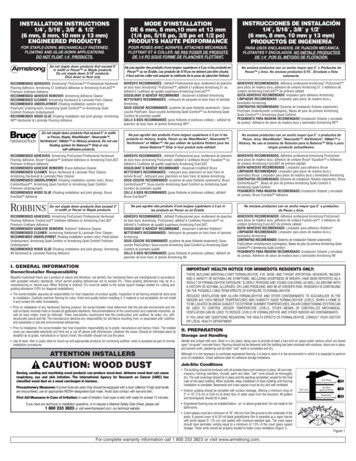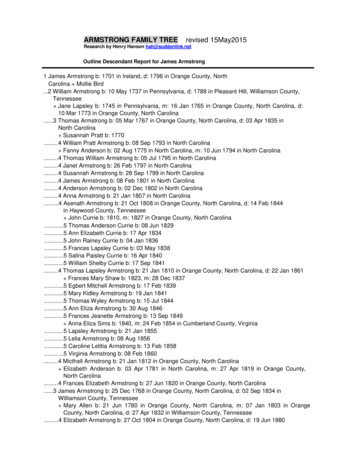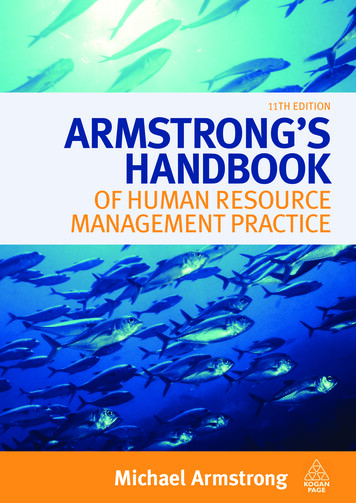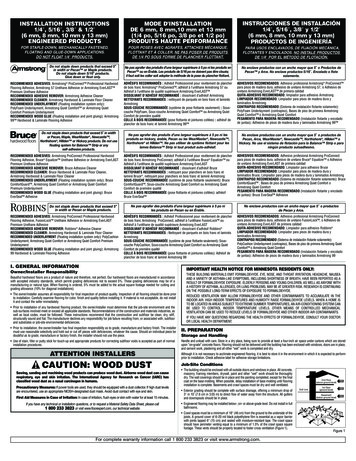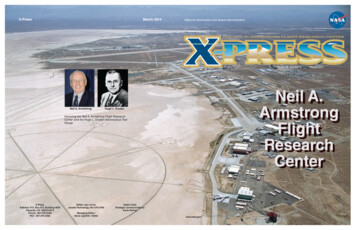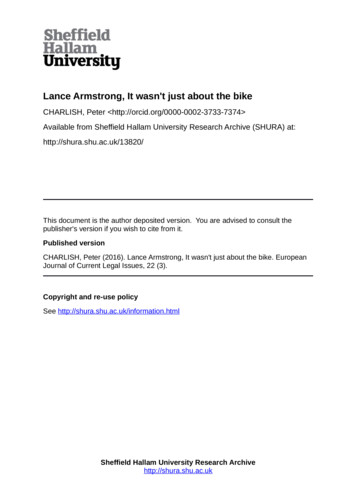
Transcription
Lance Armstrong, It wasn't just about the bikeCHARLISH, Peter http://orcid.org/0000-0002-3733-7374 Available from Sheffield Hallam University Research Archive (SHURA) at:http://shura.shu.ac.uk/13820/This document is the author deposited version. You are advised to consult thepublisher's version if you wish to cite from it.Published versionCHARLISH, Peter (2016). Lance Armstrong, It wasn't just about the bike. EuropeanJournal of Current Legal Issues, 22 (3).Copyright and re-use policySee http://shura.shu.ac.uk/information.htmlSheffield Hallam University Research Archivehttp://shura.shu.ac.uk
Lance Armstrong - It Wasn't Just About The BikeAuthor: Peter Charlish, Principal Lecturer in Law, Sheffield Hallam University [1]ABSTRACTThe paper "Lance Armstrong, It wasn't just about the bike", examines the Lance Armstrongsaga from a comparative perspective, examining what might happen if such a high profilesaga erupted in other common law jurisdictions. In doing so, it draws on wider questionsaround the concept of cheating and the specific nature of doping and the measures in placeto combat the threat of widespread abuse of performance enhancing substances. Thestandard of proof required in questions around non-analytical positives is examined andquestions around next steps for sport such as a general amnesty are raised. It is alsosuggested that the code of silence pervading some sports around doping issues may becombatted by provisions such as the Freedom of Information Act 2000 and that thislegislation may help to combat some of the mist that surrounds doping control in sport.1. INTRODUCTIONCheating has been a malign influence in sport for many years, from the match-fixing scandalof the "Chicago Black Sox" that rocked American baseball in 1919, [2] to the "Hand of God"incident at the 1986 World Cup, [3] to the Paralympics scandal involving the Spanishbasketball team. [4] All in their own way have threatened the integrity of the sportingcompetition. However, whilst match-fixing and race-fixing in particular have been highprofile challenges for sport, [5] it is the threat posed by the use of performance enhancingdrugs that has become perhaps the most pervasive example of cheating and corruption andthe biggest threat to its integrity that sport now faces.Doping in sport is of course nothing new. [6] However the scandal surrounding LanceArmstrong has provided a fresh insight into the measures that some will take in order togain an advantage over their competitors. This paper considers the reasoneddecision [7] issued by the United States Anti-Doping Agency, (USADA), and places it in thecontext of the scale of the corruption surrounding Lance Armstrong. This will be consideredand viewed in relation to the philosophy that convinces some to cheat and others to resistthat temptation.The issues raised by the whole Armstrong saga present particular difficulties for thoseresponsible for the regulation of sport. This article will focus on some of the key regulatoryissues that would face sports bodies in the United Kingdom and other common lawjurisdictions if a case similar in scale and profile to Armstrong were to erupt. In so doing,this article will address three key issues that have vexed all those with an interest in the fightagainst doping.1. The standard of proof in disciplinary/doping proceedings, particularly when setagainst what can often appear to be the very penal nature of punishments resultingfrom adverse doping findings.2. The difficulties surrounding supervision of the decision making of sports governingbodies. This issue has again been thrown into the light by the scandals of governanceengulfing both association football and athletics. Remedies appear to be in shortsupply, particularly in the light of the traditional unavailability of judicial review as a
remedy not just to athletes against their governing bodies but also perhaps moreintriguingly as a way for journalists and pressure groups to challenge anything thatmay have the feel of a whitewash or bias about it with regard to the conduct of thegoverning body or anti-doping agency. Despite the unavailability of Judicial Reviewas a remedy against sports governing bodies, it will be shown that similar remediesare available which could enhance transparency for anti-doping efforts in UK sport.It may also be suggested that this process would be enhanced if governing bodieswere added to the list of organisations subject to duties under the Freedom ofInformation Act 2000 and some of the key regulatory issues around this will beoutlined.The question will be raised in concluding this piece as to whether or not an Armstrong typesituation would either be more unlikely to occur or conversely would be more thoroughlyinvestigated in the event that it occurred in the United Kingdom. It is certainly possible thatthe suggested application of judicial review and the potential listing of sports governingbodies under the Freedom of Information Act would help to shine the light necessary toprevent or at least moderate the kind of ill governance that appears to have blighted the UCIacross the whole Armstrong saga.2. BACKGROUNDLance Armstrong has been an icon of American and world sport since he first won the Tourde France in 1999. It should not be forgotten however that he did not come from nowhere.His journey to the top was not the trajectory of a stereotypical "doping cheat". Lance hadhistory of exceptional achievement. He was World Champion in 1993 at the precocious ageof 22, [8] but then in October of 1996 disaster struck when he was diagnosed with testicularcancer. [9] The cancer ultimately spread to his lungs, abdomen and brain, at which pointdoctors suggested that his survival chance lay at around 40%. [10] That Armstrong survivedand flourished, going on to win one of the toughest sporting events in the world a recordseven consecutive times became the stuff of legend. However, his triumphs were mired incontroversy almost from the word go, and it seemed that rumour and innuendo followedArmstrong as his victories continued, [11] until his final win in 2005. [12]What has become clear subsequent to Armstrong's "outing" is that every single one of hisvictories was built on the back of performance enhancing drugs. However, one of the keyquestions that remains unanswered though is how on earth did Armstrong get away with itand for so long? His first victory came in 1999, the Tour following the Festinascandal. [13] That Tour is perhaps significant in the genesis of the Armstrong legend. CookeJ., in discussing the importance to cycling, (and the Tour in particular), of Armstrong at thatmoment in time commented;Professional cycling desperately needed a knight in shining armour and he duly arrived for the reputation of the sport he needed to be seen to be clean. [14]It was of course against that background that Armstrong forged the first of his sevenvictories. He truly was, (or at least appeared to be), the figure that cycling desperatelyneeded. Those that administered cycling wanted his to be a true story because of thedesperate state of cycling at the time and further they saw him as the opportunity to breakinto the American market. The Cycling Independent Reform Commission, (CIRC),commented:
UCI saw Lance Armstrong as the perfect choice to lead the sport's renaissance after theFestina scandal: the fact that he was American opened up a new continent for the sport, hehad beaten cancer and the media quickly made him a global star. [15]Those that followed cycling wanted his to be a true story because of him and theinspirational account that he was able to tell in surviving cancer and going on to prosper inthe Tour. It was this perfect storm of human emotion that contributed to the successfulperpetration of the Armstrong myth. It may also have been this that at least in part,persuaded those with questions to ask to refrain from addressing those questions. It is not asif there were not suspicions about Armstrong even then, during his first Tour victory. TheFrench rider Christophe Bassons was writing a daily column throughout the 1999 Tour forthe magazine, "Le Parisien". In that column, Bassons commented after one stage that thepeleton had been "shocked" by the proficiency and strength that Armstrong had shown inthe most recent mountain stage. [16] Armstrong berated Bassons on the following stage forhis insinuation that essentially suggested Armstrong may have used an artificial aid toimprove his climbing performance. In his attack on the Frenchman, Armstrong suggestedthat Bassons should leave cycling altogether for his comments. That it has subsequently beenrevealed that Armstrong tested positive for banned substances on four occasions during the1999 Tour [17] provides an interesting insight into his modus operandi.For Armstrong, the first real difficulties arose in 1999 when but for a backdated prescriptionfor cortisone [18] might have ended his pre-eminence in the Tour de France before it hadeven started. [19] Further problems arose in 2001 during the Tour de Suisse whenArmstrong returned what according to the Union Cycliste Internationale, (UCI) were"questionable" tests. These included results for EPO which the UCI confirmed were stronglysuspicious but not actually positive. This rather murky explanation was perhaps thenexacerbated by Armstrong's donation of 125,000 apparently, (according to then UCIPresident Pat McQuaid), to help in their anti-doping efforts rather than as many people mayhave assumed to help cover up a failed or suspicious drugs test. [20] Importantly thoughthis revealed vulnerabilities within his entourage as suddenly there were staff on his team,in addition to the inner sanctum of his teammates who were clearly aware of and indeedaided this falsification [21] and this would ultimately prove significant in his unmasking.Nevertheless Armstrong's success continued despite the rumours and innuendos and heeasily passed the old record of five victories in the Tour which had been jointly held by fourindividuals. [22]Controversy however continued to follow Armstrong this time via a confrontation withanother member of the peleton, Filipe Simeoni. Armstrong had worked with thecontroversial Italian doctor, Michele Ferrari regularly until Ferrari was convicted in theItalian courts of sporting fraud. Whilst he was cleared of the more serious allegations ofproviding performance enhancing drugs this was nevertheless a serious issue whichbrought Ferrari a 12 month suspended sentence. [23] This guilty verdict was basedpredominantly on the evidence provided by Filipe Simeoni and Armstrong subsequentlyaccused Simeoni of lying which prompted Simeoni to sue Armstrong for defamation. [24] Itis in response to this that Armstrong allegedly made his infamous "zip the lips" gesture toSimeoni, [25] following his unprecedented chase down during the 18th stage of the 2004Tour of a lead group which Simeoni had joined. [26] It is instructive that Armstrongsuggested that following Ferrari's conviction he ended his association with the doctor andthat Armstrong's agent even went as far as testifying under oath [27] that their professionalrelationship had been terminated. [28] However, evidence suggests that this was not thecase. Bank records showing payments between the two and witness statements demonstrate
clearly that close contact remained during 2005, [29] and further affidavits make clear thatArmstrong retained his professional relationship with Ferrari in the build up to andthroughout his comeback in 2009-2010. [30]Further difficulties emerged for Armstrong in 2004 following his sixth consecutive victory inthe Tour. This came in the shape of the SCA Arbitration hearing, [31] where Armstrong liedunder oath when questioned about the his apparent admission to a doctor made in hospitalwhilst undergoing treatment for his cancer that he had never used performance enhancingdrugs prior to his illness. [32] Then in 2005 the rumours really began to gather pace whenthe French newspaper L'Equipe published "The Armstrong Lie," which connected him to sixurine samples which had been taken during the 1999 Tour. These it is claimed testedpositive for EPO. They were however only labelled by number rather than name andfurthermore were only single samples rather than A and B samples [33] and therefore wereinsufficient, absent of any other evidence, to bring an action against Armstrong. In 2005,following his record breaking seventh successive Tour victory, (for which he recorded thehighest ever average speed at 41.7 Km/h [34] ), Armstrong announced his retirement andthere perhaps might have ended his "story". However on 9th September 2008, he announcedhis return to cycling with the specific aim of winning the Tour once again. [35] Whatfollowed however was not the glory that he had hoped for but rather relative failure on theroad, [36]and further controversy and ultimately sanction off the road as first federalprosecutors pursued him and then USADA, culminating in the USADA reasoned decision andassociated fallout which resulted in Armstrong being stripped of all of his titles and bannedfrom competitive cycling for life.The remainder of this paper will look at the reasoned decision focussing not only on theallegations that were put forward in the report but also questioning what was known and bywhom with reference to Armstrong's practices throughout his career. Limitations on spaceprevent anything more than questions being raised but nevertheless in light of the rumoursdetailed above and his final confession to Oprah Winfrey [37] it seems pertinent to ask justhow he managed to "get away with it" for so long?3. THE REASONED DECISIONOn 24th August 2012, Lance Armstrong was formerly stripped of his seven Tour de Francetitles and suffered disqualification of all results from 1st August 1998. [38]Following thatdecision it then rested with the USADA as the organisation with results managementauthority [39] to issue Armstrong with an explanation for its actions, which it duly compliedwith when it issued the reasoned decision [40] . There is a danger that all attention will remainon this document, perhaps at the expense of a thorough examination of the Federalinvestigation into allegations of doping by Armstrong that was formerly and perhapssurprisingly discontinued on 3rd February 2012, following reported politicalpressure. [41] The point is made that none of the evidence gathered by the USADA camefrom that Federal investigation. [42] It seems astonishing that, despite us living in timeswhere the signing and apparent effectiveness of memorandums of understanding betweenanti-doping organisations and various arms of law enforcement agencies at both a nationallevel, [43] and an international level [44] are proudly announced and further, that we aretold that Armstrong could not have escaped detection for so long had he committed hissporting offences today, [45] that he was nevertheless able to maintain a doping regimethroughout his illustrious career. It is clear that this was an open secret within the peloton.The reasoned decision highlights some almost farcical indicators of Armstrong's guilt, some ofwhich were apparent even before his first Tour victory. Indicators such as the carrying of a
thermos flask, which seemed to be a tell-tale sign of EPO use. [46] The reasoneddecision explains:Jonathan Vaughters also believed Armstrong was likely using EPO-there were some tell-talesigns, such as Lance carrying around a thermos. However, prior to the 1998 Vuelta a EspañaVaughters could not be absolutely sure of Armstrong's EPO use. During this time frameseveral riders, in addition to Vaughters, saw Armstrong carrying a thermos and associated itwith him using EPO. [47]With such behaviour, one again has to question the rigour with which those responsible forpolicing their sport were actually acting. With such anecdotal evidence of EPO use, onemight have expected a concentrated campaign of target testing of Armstrong and histeammates. In the aftermath of the Armstrong debacle it is perhaps instructive that Irishjournalist and former Tour de France competitor Paul Kimmage launched an action againstboth the President and former President of the UCI for "slander/defamation, denigrationand strong suspicions of fraud", [48] and further that there has been a distinct lack ofcooperation between the UCI and the World Anti-Doping Agency, (WADA), culminating inthe refusal of the WADA to engage with the UCI's commission to investigate corruptionwhich was established in the wake of the Armstrong scandal. [49] With this kind ofatmosphere surrounding the organisation charged with protecting the integrity andwellbeing of their sport, it is perhaps unsurprising that many have questioned the role of theUCI [50] in the obviously ineffective anti-doping regime which allowed Armstrong to evadedetection throughout his career.What perhaps is even more troubling is the atmosphere evident between the UCI on oneside and the USADA on the other. These are two organisations apparently seeking the samegoal - that of a drugs free sport and yet the open hostility evidenced between these twoorganisations even before the reasoned decision was published as they bickered over who hadjurisdiction in pursuing Armstrong [51] displays for all to see that there were other agendasat play rather than a desire to work towards a common goal of dealing with drug abuse inthe sport.The UCI has had at times a difficult association with not just USADA but otherorganisations, and individuals who are involved in anti-doping and in particular with theWADA and it is likely that problems with this relationship helped to sour that with USADA.The origins of the problems may be traced back to the relationship between Dick Pound, (thefirst President of the WADA), and Hein Verbruggen, (President of the UCI from 1992-2005).Verbruggen supported Jacques Rogge over Pound in his successful action to succeed JuanAntonio Samaranch as President of the International Olympic Committee and it appears thatthis may have been the starting point for the conflict [52]which would ultimately spill overto have serious consequences for anti-doping policy in cycling. The CIRC comments:It is the CIRC's view that the conflict between these two men as well as their very differentphilosophies of fighting doping in sport soured the relationship between the UCI andWADA, which adversely affected the fight against doping. [53]The CIRC relates that the problems between the WADA and the UCI appeared almost fromthe very birth of the former. From a resistance to the standard two year ban for a dopingoffence, to a reluctance to adopt the first WADA Code, [54] it seemed that the UCI werereluctant to work in partnership with the fledgling organisation. Perhaps more important
however was a fundamental disagreement over the very nature of the organisation. Thepersonal animosity between the two men seemed to spill over to their professionalrelationship as they adopted radically differing views of the nature of the WADA, (and bydefinition other anti-doping agencies too). On the one hand, Verbruggen viewed the WADAvery much as an agency to support and help governing bodies. He commented, "Pound ispositioning WADA as the watchdog and that is not its role. It should be an aid agency, not apolice agency against sport". [55] Pound's view on the role of the WADA on the other handwas far from that envisaged by Verbruggen. Bose reports his comments:We are not just a support agency, quite the opposite WADA is the international agencywhose job is to report on compliance and non-compliance with the code. [56]This viewpoint is clearly shared by the USADA which makes the point in the ReasonedDecision that:USADA exists to enforce the rules against cheating through the use of performanceenhancing drugs regardless of whether those rules are broken by the famous or theanonymous. [57]This would clearly involve at times holding governing bodies to account in the event ofperceived failures in anti-doping policy and may therefore be viewed as something thatwould impact on the independence of governing bodies and their role as sole governors oftheir sports. The potential conflict, that these differing opinions on the role of the WADAand the USADA may cause are obvious. Whilst one might expect personal relationships toalter over time, particularly when the personnel involved change, this proved not to be thecase when Verbruggen stepped down to be replaced by Pat McQuaid as President of theUCI in 2005. The CIRC report;Pat McQuaid inherited the difficult relationship between Hein Verbruggen andWADA/Dick Pound. Pat McQuaid did not disassociate himself from that dispute. Instead, itappears that he sided from the beginning of his presidency with Hein Verbruggen and thatdid little to ease the conflict. Examples of this can be found in Pat McQuaid's publishedletter to the French Ministry of Sport and Dick Pound(dated 3 July 2006) and in his callingpublicly for Dick Pound's dismissal from WADA. [58]The relationship continued to deteriorate when the UCI launched defamation proceedingsagainst Dick Pound, and indeed several other stakeholders around that time and promptedthe CIRC to comment:It seemed to have been part of the UCI's strategy to threaten and/or serve their opponentsor critics with legal actions, be it before state courts or ethical commissions. [59]That this antipathy might affect the relationship that the UCI had with other stakeholders,(in particular other anti-doping agencies such as USADA), seemed likely and indeed thatwas acknowledged by the CIRC. [60] The most worrying aspect of this was of course theimpact that these problematic relationships might have on anti-doping within cycling.Indeed it has only been subsequent to USADA's Reasoned Decision that reforms have beenput in place at least in part to separate anti-doping operations within cycling from the UCIleadership. [61]
The aftermath of the pursuit of Armstrong has shown little or no signs of leading to a thawin the relationship between the two organisations as further tensions remain evident. [62] Itcan only be hoped that the appointment of Brian Cookson as new President of theUCI, [63] replacing Pat McQuaid, in September 2013 will facilitate a more positiverelationship between the organisations.It is clearly tempting to view the USADA as the "clean" organisation seeking to maintain adrug free sport and to pursue those it suspects of cheating to the fullest extent and the UCIas the organisation mired in controversy and seemingly dragging its heels in attempting tomaintain a drug free sport. One might argue that the UCI as the guardian and promoter ofits sport has a conflict of interests that might tempt it to maintain a silence around dopingissues - a conflict that the USADA do not have. However the USADA do not escape judicialcriticism, an issue which they appear to gloss over in the reasoned opinion. Their "woefullyinadequate charging letter", [64] drew criticism from the Court in Armstrong vTygart [65] and it is certainly possible as one or two appear to have done, to view the pursuitof Armstrong as something of a personal mission for Travis Tygart and theUSADA. [66] The bottom line though remained the desire of the USADA to maintain a drugfree sport on the one hand against Lance Armstrong's right to protect his past and futurecareer on the other.In seeking to address concerns about the balance of rights, The Court made clear reference tothe safeguards in place that may serve to ease fears that Armstrong would not be treatedfairly. However, despite their obvious misgivings with the process and balance of power,they concluded, "the Court finds the USADA arbitration rules . are sufficiently robust tosatisfy . due process". [67] The Court was comfortable with Armstrong's options and thedegree of protection offered to Armstrong via the operation of International arbitrationsystem and in particular the Court of Arbitration for Sport. Sparks commented;Alternatively, even if the Court has jurisdiction over Armstrong's remaining claims, theCourt finds they are best resolved through the well- established system of internationalarbitration, by those with expertise in the field. [68]The Court continued:Armstrong has ample appellate avenues open to him, first to the Court of Arbitration forSport, (CAS), where he is entitled to de novo review, and then to the courts of Switzerland,as permitted by Swiss law, if he so elects. [69]The question may however be asked, particularly in the light of the ongoing case involvingGerman speed-skater Claudia Pechstein as to whether the Court was right to have such faithin the International arbitration process.The balance in terms of the protection of athlete rights offered by the Court of Arbitrationfor Sport and the Swiss Federal Tribunal, (SFT) has recently been thrown into doubt by thedecision of the Munich Court of Appeals to refuse to recognise the CAS arbitration award inthe case of Claudia Pechstein who had originally been banned from competing due toirregularities with her Biological Passport profile. That this case had been through the CAS,the Swiss Federal Tribunal, and a further request for revision before the SFT provedirrelevant as the Munich Court to whom Pechstein had brought her case cited concern overcompatibility with German cartel law and public policy.[70] The progress of the case raises
real concerns about the finality of decisions rendered by the CAS and therefore calls intoquestion the status of sports ability to govern itself. Diathesopoulou comments:Challenging the validity of CAS awards before national courts, however, is something newunder the sun of sports arbitration and could prove fatal for the finality of CAS awards,which is a sine qua non safeguard of procedural equal treatment among athletes and legalcoherence in sports law. [71]The particular problem was not with the award itself but more the process by which it wasarrived at. The ISU, (the governing body), much like the vast majority of sports governingbodies, (absent perhaps boxing and to a lesser degree darts), enjoys a monopolistic positionin the governance of their sport and essentially force their participants to accept compulsoryarbitration by the CAS. This in itself may not be problematic when one considers it in thelight of the acknowledged specificity of sport, [72] and the clear need for there to beconsistency in the administration of sports. What made the CAS decision problematic wereprocesses around the decision. Diathesopoulou comments: the Court hold that the arbitration agreement as a prerequisite to the athlete'sparticipation in competitions does not constitute per se an abuse of a dominant position,since it responds to the specificity of sport and particularly to the need of consistency insports disputes. However, considering the decisive influence of sports organizations on theselection and appointment of arbitrators under the CAS regulations, the Court concludedthat the independence of CAS is questionable. In this light, forcing the athletes to sign anarbitration agreement in favour of a rather dependent and partial tribunal would constitutean abuse of the international sports organizations' dominant position in the market, therebyinfringing the mandatory German antitrust law. [73]The Court's conclusion was that the dominant position enjoyed by the ISU meant that theterms it imposed upon Ms Pechstein, (compulsory arbitration in the CAS), were contrary tothe German Act against restraints of Competition. Further that the choice of arbitratorsunder the then existing rules was biased in favour of the ISU and therefore by definitionother governing bodies. Voser comments:The court furthermore noted that the structural imbalance between athletes and sportsrelated bodies is aggravated by the fact that in all disputes concerning decisions of sportsrelated bodies, the president of the arbitral tribunal is directly appointed by the President ofthe CAS Appeals Division who is a member of the International Council of Arbitration forSport ("ICAS"), a body that is highly dependent on the sports-related bodies. According tothe Higher Court, athletes accept this one-sided designation of the CAS arbitrators onlybecause they have no choice if they want to compete at an international level. [74]Pechstein's case was heard by the CAS before the reforms of 2012 which brought greaterindependence to the process of selecting arbitrators, removing the quotas of arbitratorsnominated by governing bodies and similar organisations. [75] It is therefore possible thatthis case may prove to be a one off and that the rendering of sports arbitration decisions willcontinue to rest easily with the CAS. Should this prove not to be the case then we may be infor further CAS reform. Diathesopoulou, in making this point stresses;
Therefore, a potential institutional reform of the CAS to ensure independence andimpartiality coupled with a more stringent review of its awards by the SFT should bringabout a more restraint approach of national courts when reviewing CAS awards' compliancewith domestic public policy and ensure the subsequent finality of CAS awards. [76]Sport can ill-afford to be left without a common final dispute resolution mechanism and it ispossible to see how this process may not be the safeguard for Armstrong that perhaps theTexas Court had suggested.The Court in Armstrong v Tygart, [77] also drew attention to perhaps an issue of concern inthe USADA's pursuit of Armstrong. It stated, "it appears USADA's evidence will revolvemore around eyewitness testimony than lab results". [78] What this meant of course was thatthe smoking gun of a failed test was lacking and that this therefore left a slightlyunsatisfactory taste in the mouth. The consequences of the lack of a test failure meant thatthe USADA had to prove to the comfortable satisfaction [79]
across the whole Armstrong saga. 2. BACKGROUND . Lance Armstrong has been an icon of American and world sport since he first won the Tour de France in 1999. It should not be forgotten however that he did not come from nowhere. His journey to the top was not the trajectory of a stereotypical "doping cheat". Lance had history of exceptional .

